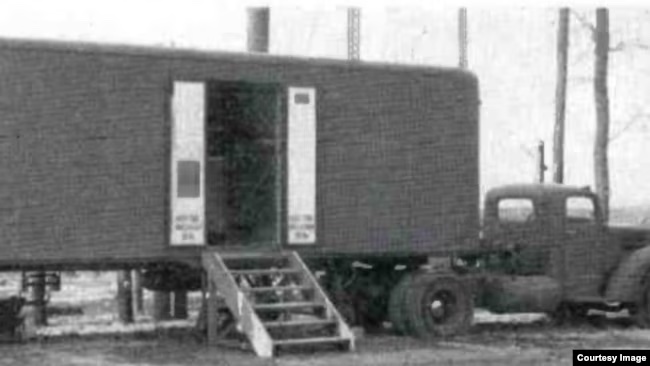Barbara: The Original Voice Of RFE

A group of men leave the breakfast table taking their last sip of coffee or bite of a roll. Engaging in small talk, they take a short drive, pass through a security checkpoint, and arrive at an encampment of trucks and trailers. They now fan out and begin their morning duties. This is all routine and nothing indicates anything out of the ordinary is going to happen, as it should be.
A generator is started, adding to the din that already permeates the camp. When fully warmed up, its frequency is synchronized with another already running, allowing them to operate as one. As additional systems are powered up, electricity surges outward like a blood supply through arteries. This is no different than any living thing, where every organ has a purpose and a responsibility to the whole. Each unit gets full nourishment to perform its dedicated and critical role. Fine-tuning the system brings it to its optimum operating condition.
Well-practiced checklists and procedures are followed to insure nothing is missed or overlooked. Nothing is left to chance. There is no room for failure.
TR-CHUNK!!
A switch is thrown and over 400 kilometers to the East, a voice last heard in New York City is saying, “Radio Free Europe is Calling.”
It is 7:30 a.m., July 4, 1950, and you’ve just witnessed the first transmission of Barbara and the birth of Radio Free Europe.
Barbara is a Radio Corporation of America (RCA) 7,500-watt mobile shortwave transmitter erected near Lamperthiem, West Germany, for the sole purpose of broadcasting to over three million receivers in Czechoslovakia, Romania, Hungry, Poland, and Bulgaria. In her seven-truck constellation there is everything that is necessary to put a full shortwave radio station into operation: power generation, studio, control room, antennas, and the ever-important transmitter herself.
The engineers don’t know the name of the person who made that first broadcast. But it’s just one of Barbara’s many voices. She has her own voice, too. We can hear it, and a few can understand what she’s saying. Hers is one of hums and vibrations that tell us how well she’s feeling and in tune with what she’s doing, much like a finely tuned race car.
Barbara’s other voices are those passing through telling us about what’s happening in their own country, by their own people, and in their own languages. Barbara’s other voices are those of Czechoslovakia, Romania, Hungry, Poland, and Bulgaria.
But the astronomical feat of going from concept to reality in broadcasting within six months isn’t ending. It’s only beginning. On July 4, 1950, Barbara transmitted to Czechoslovakia to a potential 1.8 million receivers. By July 14 she reached Romania (243,000), followed on August 4 to Hungry and Poland (400,000 and 650,000), and August 14 to Bulgaria (168,000). By the end of 1950, Barbara was broadcasting an hour and a half daily to these countries.
This wasn’t the end of what Barbara would do. As she was replaced with higher powered shortwave transmitters in Biblis, near Lampertheim, and a mediumwave transmitter in Holtzkirchen, south of Munich, she would be disassembled and transported to Portugal to, once again, make a first transmission to Czechoslovakia. This would be on July 4, 1951, twelve months to the day from her first broadcast in Germany.
Barbara was now reduced to six vehicles, but became the seedling for what was to be one of the largest shortwave transmitter sites in Europe, RARET’s Gloria retransmission site. Within the next twelve months, Barbara would be joined by four 50,000-watt shortwave transmitters. And by the early 1960s, four 100,000-watt and eight 50,000-watt transmitters would be housed there.
Barbara was truly the beginning of something greater.
Barbara would continue transmitting from Gloria for the next nine years, taking her place next to higher-powered transmitters all around her. In 1960, she was again packed up and this time shipped to the United States. Whether she got there or not is unknown.
At the same time, however, a 50,000-watt mediumwave transmitter that Radio Free Europe used in the German border area with Czechoslovakia, outside Cham, named Eagle, was being shipped to the Caribbean island of Swan. The 50,000-watt transmitter has been specifically identified as one used by Radio Free Europe, and records include a 7,500-watt shortwave transmitter in the same shipment. Is this Barbara? How many 7,500-watt RCA shortwave transmitters were available around Europe at the time?
The Swan Island transmission site was used to support the 1961 U.S. Bay of Pigs invasion of Cuba. Both transmitters played roles in supporting the insurgent forces and transmitting propaganda. After the operation failed, they continued to operate and eventually became known as Radio America. The medium wave transmitter was removed in 1970 and sent to South Vietnam. The shortwave transmitter was last heard in 1966 and was reportedly to be used in South Africa for Christian broadcasting, although nothing ever powered up there.
What happened to Barbara? Unfortunately, we may never know.
How has Barbara affected Radio Free Europe? She was the beginning of what we’ve become today. The innumerable number of hours we broadcast daily on a multitude of platforms and through various transmission mediums at one time relied solely on a little transmitter named Barbara.
The value of what Barbara did and what she represented cannot be measured in dollars. Her value can only be measured in the millions of lives she, and her successors, have touched. She was more than sheet metal, electrical circuits, and vacuum tubes.
Barbara represents everything Radio Free Europe has represented for the past seventy years.